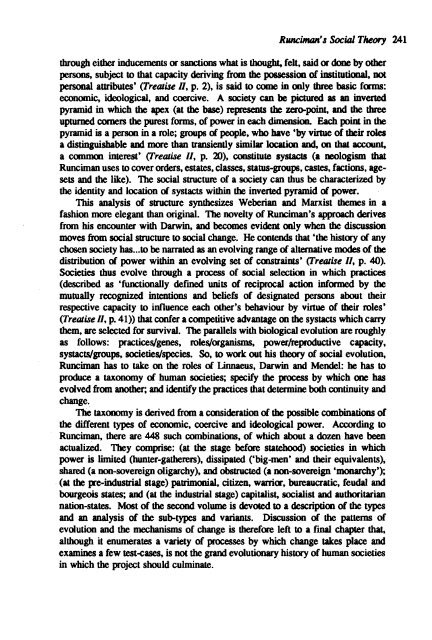1991 No. 1 CONTENTS - Institute of Social and Cultural ...
1991 No. 1 CONTENTS - Institute of Social and Cultural ...
1991 No. 1 CONTENTS - Institute of Social and Cultural ...
You also want an ePaper? Increase the reach of your titles
YUMPU automatically turns print PDFs into web optimized ePapers that Google loves.
RlIIICiman's <strong>Social</strong> Theory 241<br />
through either inducements or sanctions what is thought, felt, said or done by other<br />
persons, subject to that capacity deriving from the possession <strong>of</strong> institutional, DOt<br />
personal atuibutes' (Treatise 11, p. 2), is said to come in only three basic foons:<br />
economic, ideological, <strong>and</strong> coercive. A society can be pictured as an inverted<br />
pyramid in which the apex (at the base) represents the zero-point, <strong>and</strong> the three<br />
upturned corners the purest forms, <strong>of</strong> power in each dimension. Each point in the<br />
pyramid is a person in a role; groups <strong>of</strong> people, who have 'by virtue <strong>of</strong> their roles<br />
a distinguishable <strong>and</strong> more than ttansiently similar location <strong>and</strong>, OIl that account,<br />
a commoo interest' (Treatise 11, p. 20), coostitute systacts (a neologism that<br />
Runciman uses to cover orders, estates, classes, status-groups, castes, factions, agesets<br />
<strong>and</strong> the like). The social sttucture <strong>of</strong> a society can thus be characterized by<br />
the identity <strong>and</strong> location <strong>of</strong> systacts within the inverted pyramid <strong>of</strong> power.<br />
This analysis <strong>of</strong> sttucture synthesizes Weberian <strong>and</strong> Marxist themes in a<br />
fashion more elegant than original. The novelty <strong>of</strong> Runciman's approach derives<br />
from his encounter with Darwin, <strong>and</strong> becomes evident only when the discussion<br />
moves from social sttucture to social change. He contends that 'the hist(X}' <strong>of</strong> any<br />
chosen society has ... to be narrated as an evolving range <strong>of</strong> alternative modes <strong>of</strong> the<br />
disttibution <strong>of</strong> power within an evolving set <strong>of</strong> ccmttaints' (Treatise 11, p. 40).<br />
Societies thus evolve through a process <strong>of</strong> social selection in which practices<br />
(described as 'functionally dermed units <strong>of</strong> reciprocal action informed by the<br />
mutually recognized intentions <strong>and</strong> beliefs <strong>of</strong> designated persons about their<br />
respective capacity to influence each other's behaviour by virtue <strong>of</strong> their roles'<br />
(Treatise 11, p. 41» that confer a competitive advantage on the systacts which carry<br />
them, are selected for survival. The parallels with biological evolution are roughly<br />
as follows: practices/genes, roles/organisms, power/reproductive capacity,<br />
systacts/groups, societies/species. So, to work out his theory <strong>of</strong> social evolution,<br />
Runciman has to take on the roles <strong>of</strong> Linnaeus, Darwin <strong>and</strong> Mendel: he has to<br />
produce a taxonomy <strong>of</strong> human societies; specify the process by which one has<br />
evolved from another; <strong>and</strong> identify the practices that determine both continuity <strong>and</strong><br />
change.<br />
TIle taxonomy is derived from a coosideration <strong>of</strong> the possible combinations <strong>of</strong><br />
the different types <strong>of</strong> economic, coercive <strong>and</strong> ideological power. According to<br />
Runciman, there are 448 such combinations, <strong>of</strong> which about a dozen have been<br />
actualized. They comprise: (at the stage before statehood) societies in which<br />
power is limited (hunter-gatherers), dissipated ('big-men' <strong>and</strong> their equivalents),<br />
shared (a non-sovereign oligarchy), <strong>and</strong> obstructed (a non-sovereign 'monarchy');<br />
(at the p-e-industtial stage) pabimonial, citizen, warria-, bureaucratic, feudal <strong>and</strong><br />
bourgeois states; <strong>and</strong> (at the industrial stage) capitalist, socialist <strong>and</strong> authoriWian<br />
nation-states. Most <strong>of</strong> the second volume is devoted to a descriptioo. <strong>of</strong> the types<br />
<strong>and</strong> an analysis <strong>of</strong> the sub-types <strong>and</strong> variants. Discussion <strong>of</strong> the patterns <strong>of</strong><br />
evolution <strong>and</strong> the mechanisms <strong>of</strong> change is therefore left to a fmal chapter that,<br />
although it enumerates a variety <strong>of</strong> processes by which change takes place <strong>and</strong><br />
examines a few test-cases, is not the gr<strong>and</strong> evolutionary history <strong>of</strong> human societies<br />
in which the project should culminate.
















